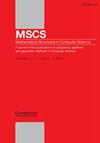On Petrie cycle and Petrie tour partitions of 3- and 4-regular plane graphs
IF 0.9
4区 计算机科学
Q4 COMPUTER SCIENCE, THEORY & METHODS
引用次数: 0
Abstract
Abstract Given a plane graph $G=(V,E)$ , a Petrie tour of G is a tour P of G that alternately turns left and right at each step. A Petrie tour partition of G is a collection ${\mathscr P}=\{P_1,\ldots,P_q\}$ of Petrie tours so that each edge of G is in exactly one tour $P_i \in {\mathscr P}$ . A Petrie tour P is called a Petrie cycle if all its vertices are distinct. A Petrie cycle partition of G is a collection ${\mathscr C}=\{C_1,\ldots,C_p\}$ of Petrie cycles so that each vertex of G is in exactly one cycle $C_i \in {\mathscr C}$ . In this paper, we study the properties of 3-regular plane graphs that have Petrie cycle partitions and 4-regular plane multi-graphs that have Petrie tour partitions. Given a 4-regular plane multi-graph $G=(V,E)$ , a 3-regularization of G is a 3-regular plane graph $G_3$ obtained from G by splitting every vertex $v\in V$ into two degree-3 vertices. G is called Petrie partitionable if it has a 3-regularization that has a Petrie cycle partition. The general version of this problem is motivated by a data compression method, tristrip, used in computer graphics. In this paper, we present a simple characterization of Petrie partitionable graphs and show that the problem of determining if G is Petrie partitionable is NP-complete.关于3-和4-正则平面图的Petrie环和Petrie tour划分
摘要给定平面图$G=(V,E)$, G的Petrie巡回是每一步交替向左和向右转的G的巡回P。G的Petrie tour分区是Petrie tour的集合${\mathscr P}=\{P_1,\ldots,P_q\}$,使得G的每条边都恰好在一个tour $P_i \in {\mathscr P}$中。如果一个皮特里环的顶点都是不同的,那么它就叫做皮特里环。G的Petrie环划分是一个Petrie环的集合${\mathscr C}=\{C_1,\ldots,C_p\}$,使得G的每个顶点恰好在一个循环$C_i \in {\mathscr C}$中。本文研究了具有Petrie循环划分的3正则平面图和具有Petrie循环划分的4正则平面多图的性质。给定一个4-正则平面多图$G=(V,E)$, G的3-正则化是将V$中的每个顶点$ V \拆分为两个3次顶点,得到一个由G得到的3-正则平面图$G_3$。G被称为皮特里可分的如果它有一个3正则化并且有一个皮特里循环划分。这个问题的一般版本是由计算机图形学中使用的数据压缩方法tritrip引起的。本文给出了Petrie可分图的一个简单刻划,并证明了判定G是否Petrie可分的问题是np完全的。
本文章由计算机程序翻译,如有差异,请以英文原文为准。
求助全文
约1分钟内获得全文
求助全文
来源期刊

Mathematical Structures in Computer Science
工程技术-计算机:理论方法
CiteScore
1.50
自引率
0.00%
发文量
30
审稿时长
12 months
期刊介绍:
Mathematical Structures in Computer Science is a journal of theoretical computer science which focuses on the application of ideas from the structural side of mathematics and mathematical logic to computer science. The journal aims to bridge the gap between theoretical contributions and software design, publishing original papers of a high standard and broad surveys with original perspectives in all areas of computing, provided that ideas or results from logic, algebra, geometry, category theory or other areas of logic and mathematics form a basis for the work. The journal welcomes applications to computing based on the use of specific mathematical structures (e.g. topological and order-theoretic structures) as well as on proof-theoretic notions or results.
 求助内容:
求助内容: 应助结果提醒方式:
应助结果提醒方式:


